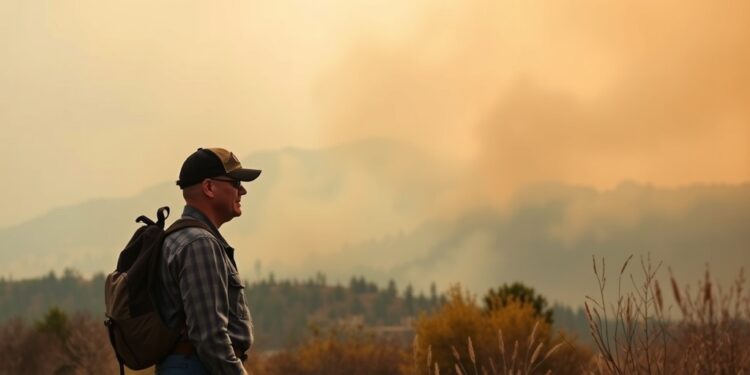Exposure to fine particulate matter (PM2.5) generated by wildfires has increasingly been recognized as a significant contributor not just to physical health challenges but also to mental health vulnerabilities among affected populations. A groundbreaking study emerging from the Harvard T.H. Chan School of Public Health has revealed compelling evidence of the correlation between wildfire smoke exposure and elevated emergency department (ED) visits due to various mental health conditions. This study emphasizes a crucial intersection between environmental exposures and public health, highlighting how climate-related events can exacerbate pre-existing health disparities, especially among vulnerable groups.
The researchers meticulously analyzed data spanning California’s notorious 2020 wildfire season, which was marked by unprecedented PM2.5 levels. By focusing specifically on this wildfire-related particulate matter, the study distinguished itself from previous research that largely centered on broader categories of air pollution. In doing so, it provided a nuanced understanding of the acute effects of wildfire-derived PM2.5, demonstrating that this environmental hazard is not solely a respiratory concern but also a significant player in deteriorating mental health outcomes.
The data encompassed a staggering number of ED visits—over 86,000 during the research period—highlighting the severe impact of wildfire smoke on the general public. The results disclosed a clear pattern: as PM2.5 concentrations increased, so did the number of visits for various mental health diagnoses, including mood disorders, anxiety, and substance use issues. The relationship between spikes in particulate matter and mental health crises unfolded in a timely manner—up to a week following exposure—indicating immediate and serious ramifications for those caught in the smoke’s path.
Gender, age, race, and socioeconomic status emerged as significant factors influencing the likelihood of mental health-related ED visits stemming from wildfire exposure. Women, youth, and individuals from racial minority groups, particularly Black and Hispanic populations, showed remarkably higher susceptibility to mental distress linked to smoke exposure. Medicaid enrollees also emerged as a particularly vulnerable demographic, underscoring existing health inequities that are potentially exacerbated by environmental conditions.
The lead author of the study, YounSoo Jung, emphasized the critical need for targeted mental health interventions in the wake of wildfires, stating that the disparities highlighted by the research necessitate immediate action. As climate change renders wildfires more frequent and intense, it becomes imperative that policymakers and health organizations prioritize mental health care access for those disproportionately affected by environmental factors. The implications of the study are substantial, pushing the boundaries of how public health discourses consider the intersectionality of climate change and mental well-being.
Furthermore, the research suggests that mental health resources should be scaled up during wildfire seasons, particularly in regions prone to these catastrophic events. With wildfires becoming a chronic problem rather than an isolated crisis, the mental toll associated with prolonged exposure to wildfire smoke could have enduring effects on community health. Access to timely mental health care, community support systems, and effective communication about the psychological impacts of smoke exposure are vital components for mitigating this growing public health concern.
Importantly, this study contributes to a growing body of research that aims to establish a clearer understanding of how air pollution, particularly PM2.5 from wildfires, impacts mental health. While previous findings have often linked overall air pollution to psychological disorders, this specific investigation into wildfire smoke allows for more tailored public health responses. As researchers continue to explore the multifaceted effects of climate change on health, this particular study paves the way for future investigations to examine specific pollutants and their psychological consequences.
As the scientific community delves deeper into these relationships, interdisciplinary approaches will be critical. Collaborations between environmental scientists, psychologists, and public health professionals can produce more comprehensive strategies to address the mental health repercussions associated with climatic disasters. By recognizing the breadth of mental health risks posed by environmental factors, health practitioners can implement more preventive measures aimed at safeguarding the mental well-being of populations vulnerable to seasonal catastrophes.
In light of the study’s findings, it becomes increasingly apparent that individuals residing in high-risk areas must be equipped with knowledge and resources to manage their mental health amidst environmental changes. Schools, workplaces, and community organizations all have roles to play in fostering resilience against mental health adversities linked to climate phenomena. As public health systems adapt to the evolving landscape of health threats, the integration of mental health support into environmental planning becomes crucial.
In summary, this research not only underscores the immediate dangers posed by wildfire smoke but also calls for a paradigm shift in how public health strategies can evolve in response to climate change. By highlighting the mental health consequences of particulate matter exposure, particularly during wildfire seasons, the study serves as an urgent call to action. It is essential for communities, healthcare providers, and policymakers to collaboratively formulate empirical strategies informed by these findings to ensure mental health remains a priority amidst escalating environmental challenges.
The continuous cycle of climate change and wildfires signals that mental health considerations should become integral to environmental health discussions. This research should not be an isolated case but rather a instigator for broader dialogues on health, environment, and society as they become increasingly intertwined amidst the realities of climate change.
Each wildfire season and its subsequent health impact demands a well-coordinated response that includes health education, community support systems, and immediate access to mental health services. The confluence of environmental degradation and health disparities emphasizes the need for a holistic approach, particularly as we face uncertain futures fraught with the threats of climate impacts on both physical and mental health dimensions.
Subject of Research: Wildfire-related PM2.5 and its impact on mental health outcomes
Article Title: PM2.5 from 2020 California Wildfires and Mental Health-Related Emergency Department Visits
News Publication Date: April 4, 2025
Web References: Harvard T.H. Chan School of Public Health
References: JAMA Network Open, DOI: 10.1001/jamanetworkopen.2025.3326
Image Credits: N/A
Keywords: PM2.5, wildfire smoke, mental health, environmental health, public health, air pollution, California wildfires.




